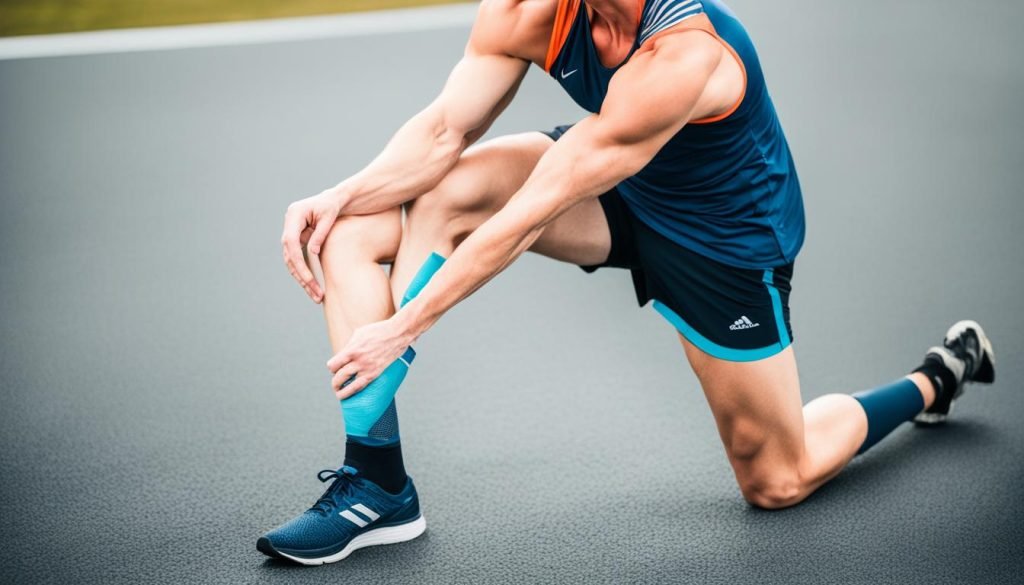Ever felt pain in your legs after running, even on great days? Running is great for fitness, but it can also cause leg pain. It's important to know why you might feel sore and how to recover well. This article will help you understand leg pain better, so you can tell normal soreness from serious issues.
Key Takeaways
- Leg pain after running can vary from mild soreness to intense discomfort.
- Normal muscle soreness is usually experienced after increased intensity, while sharp pain may indicate injury.
- Effective recovery techniques, including hydration and proper rest, are essential for long-term running success.
- Regularly assess your running form and footwear to prevent unnecessary leg pain.
- Understanding your body’s signals can help you distinguish between safe soreness and a need for professional advice.
Understanding Leg Pain in Runners
Many runners know the pain in their legs all too well. It can feel different and vary in intensity. Knowing the types of leg pain helps figure out how to treat or prevent it. It's important to know if the pain feels aching or sharp. This can change how runners train or recover. Some common areas of discomfort in runner's legs also lead to specific pain patterns.
Types of Leg Pain
Runners may feel different kinds of leg pain during or after running. The main types include:
- Aching: This pain comes from using the muscles too much or getting tired.
- Sharp pain: This is a sudden, intense feeling that might mean an injury.
- Cramps: These are sudden muscle spasms that cause a lot of pain.
Aching vs. Sharp Pain
It's important for runners to know the difference between aching vs. sharp pain. Aching usually means small muscle tears or being very tired from running a lot. This pain is often seen as normal. But sharp pain could mean a serious injury, like a strain or tendinitis, and shouldn't be ignored.
Common Areas of Discomfort
Knowing where pain often happens in runner's legs can help with training or seeing a doctor. These spots often have issues:
| Body Part | Common Issues |
|---|---|
| Knees | Pain from runner's knee or patellar tendinitis |
| Shins | Shin splints, often due to impact stress |
| Calves | Muscle strains or tightness |
| Achilles Tendon | Achilles tendinitis, commonly affecting runners |
Why Do My Legs Ache After a Run?
Many athletes feel leg soreness after running. It's important to know the difference between normal and severe pain. This helps with recovery and avoiding injuries. The body adapts to new workouts, causing these feelings.
Normal Muscle Soreness vs. Severe Pain
Normal muscle soreness feels like a dull ache after exercise. It happens often, especially after hard workouts or new routines. It goes away with rest and doesn't usually affect daily life. But, severe pain is a different story. It can get worse with exercise and might mean a serious injury. Knowing the difference helps runners make smart choices about their training.
Delayed Onset Muscle Soreness Explained
Delayed onset muscle soreness (DOMS) is a type of soreness that peaks 24 to 72 hours after exercise. It makes muscles stiff and uncomfortable as they heal and adapt. DOMS is common with new or intense running. Knowing about it helps manage it and keep running healthy.

| Type of Soreness | Onset Time | Characteristics | Management |
|---|---|---|---|
| Normal Muscle Soreness | Within 24 hours | Dull ache, subsides with rest | Light stretching, gradual return to activity |
| Severe Pain | Immediate or delayed | Persistent, worsens with activity | Rest, consult healthcare professional |
| Delayed Onset Muscle Soreness (DOMS) | 24-72 hours | Stiffness, tenderness | Active recovery, massage, hydration |
Common Causes of Leg Pain After Running
For any runner, knowing why leg pain happens is key. There are many reasons, from physical strain to body chemistry changes.
Muscle Strain and Overexertion
Muscle strain happens when you do intense activities, especially during high-impact runs. Overexertion stretches muscles too far, causing pain. This often happens when runners go beyond what their bodies can handle, leading to muscle tiredness.
Lactic Acid Buildup
When you exercise hard, your body uses glucose for energy, making lactic acid. If you don't get rid of lactic acid, it builds up in muscles. This makes muscles stiff and painful. Knowing this helps runners control their effort during workouts.
Hydration and Electrolyte Imbalance
Staying hydrated is key for healthy muscles. Not drinking enough water can lead to an imbalance of electrolytes, making muscle cramps worse. Runners who lose a lot of fluids and don't replace them are more likely to feel leg pain.
Identifying and Treating Muscle Soreness
For runners, knowing how to spot muscle soreness is key. It's important to tell normal from abnormal soreness to help with recovery and improve performance. Normal soreness is usually mild and means your muscles are tired. But, abnormal soreness can be sharp, cause inflammation, or swelling.
Signs of Normal vs. Abnormal Muscle Soreness
Here's how to tell normal from abnormal muscle soreness:
- Normal soreness: It's mild and goes away with activity.
- Abnormal soreness: It's sharp, with swelling or stiffness.
- Recovery time: Normal soreness heals in a few days. Abnormal soreness takes longer and might need a doctor.
Home Remedies for Relief
There are many home remedies for muscle soreness. The RICE method—rest, ice, compression, and elevation—can help. Also, try these to recover faster:
- Gentle stretching: It makes muscles more flexible.
- Warm baths or showers: They relax sore muscles.
- Topical creams: They give targeted pain relief.
The Role of Rest and Recovery Techniques
Rest is key for muscle recovery. Here are ways to support recovery:
- Quality sleep: It helps muscles repair.
- Active rest days: Do low-impact activities like walking or yoga.
- Massage therapy: It improves circulation and eases muscle tightness.

| Type of Soreness | Signs | Recommended Action |
|---|---|---|
| Normal Soreness | Mild discomfort, improves with activity | Rest, gentle stretching, hydration |
| Abnormal Soreness | Severe pain, swelling, prolonged discomfort | Ice, compression, seek medical advice |
Preventive Measures to Avoid Leg Pain
To prevent leg pain, focus on a few key practices. Start with effective warm-up techniques before running. This gets your muscles and joints ready, lowering the chance of getting hurt. It also prepares your body for harder activities, which is key for runners.
Importance of Warm-up and Cool-down
Having a good warm-up and cool-down is crucial. A proper warm-up boosts blood flow and flexibility, helping you perform better. A cool-down brings your heart rate back down and helps your muscles recover.
Correct Running Form and Footwear
Running with the right form is key to avoiding pain. Good running mechanics can help prevent pain from stress or overuse. Also, picking the right shoes is important. They should match your foot type and how you run.
Gradual Progression in Training
Increasing your training slowly is vital to avoid injuries. The 10% rule suggests not increasing your distance or intensity by more than 10% each week. This helps build endurance safely and prevents injuries by letting your body adjust slowly.

| Preventive Measure | Description | Benefits |
|---|---|---|
| Warm-up Techniques | Gradual exercises to prepare muscles for running. | Reduces injury risk, improves performance. |
| Correct Running Form | Using proper biomechanics while running. | Minimizes stress on legs and joints. |
| Proper Footwear | Choosing shoes that fit your running style. | Offers adequate support, reducing pain. |
| Gradual Progression | Increasing running intensity and distance slowly. | Helps prevent overuse injuries. |
When to Seek Professional Help
Knowing when you need professional help is key to avoiding long-term damage and getting better fast. Spotting serious injury signs early can prevent things from getting worse. Look out for these important signs that mean you should see a doctor.
Signs That Pain Might Indicate a Serious Injury
- Sharp, persistent pain that does not improve with rest
- A noticeable drop in performance levels
- Swelling or bruising in the affected area
- Inability to bear weight or use the injured leg
- Changes in sensation, such as numbness or tingling
Common Running Injuries to Watch For
Knowing about common running injuries helps with the right treatment. Here are some to keep an eye on:
| Injury | Description | Symptoms |
|---|---|---|
| Runner's Knee | Pain around the knee cap due to misalignment or overuse | Sharp pain during activity, swelling |
| Shin Splints | Pain along the shin bone caused by overuse | Aching pain in the front of the lower leg |
| Stress Fractures | Tiny cracks in the bone from repetitive force | Localized pain that worsens with activity |

Conclusion
Managing leg pain is key to enjoying running without discomfort. Runners need to know the different types and causes of leg pain. This helps them tell normal soreness from serious issues.
Knowing how to avoid leg pain helps too. This includes doing proper warm-ups, wearing the right shoes, and slowly increasing training. These steps can greatly lower the chance of getting hurt.
A complete approach is best for staying healthy and loving running. It includes being aware, getting the right treatment, and preventing pain. By doing this, runners can keep up their fitness and enjoy running more.
FAQ
Why do my legs ache after a run?
Your legs might ache after running because of muscle soreness. This happens when your muscles get used to more activity. It's usually a mild pain that goes away with rest. But, if the pain is sharp or doesn't go away, you might have an injury.
What is delayed onset muscle soreness (DOMS)?
DOMS is muscle soreness that happens after hard exercise. It gets worse between 24 to 72 hours after and feels like muscle stiffness and soreness. It's normal when you start new exercises or do more intense workouts.
How can I differentiate between normal muscle soreness and an injury?
Normal soreness feels like a dull ache that gets better with movement. An injury hurts more, swells, or gets red. If the pain doesn't get better or gets worse, see a doctor to check for serious problems.
What causes muscular pain after running?
Running can cause muscle pain from strain, doing too much, lactic acid, not drinking enough water, or not having enough electrolytes. Knowing these causes helps you recover better.
What are effective home remedies for relieving leg pain?
Good home remedies are rest, ice, compression, and elevation (RICE). Also, stretching gently, massaging sore spots, and eating right helps your muscles recover and feel better.
How can I prevent leg pain when running?
To prevent leg pain, warm up and cool down properly, run right, wear good shoes, and don't increase your training too fast. This helps avoid injuries.
When should I seek professional help for leg pain?
Get help if you have sharp, ongoing leg pain, swelling, or your performance drops. A doctor can check for issues like runner's knee, shin splints, or stress fractures.
Source Links
- Leg Pain After Running: Identify Normal vs. Abnormal Signs – https://backcountry.physio/leg-pain-after-running/
- Common Running Injuries: Causes, Prevention, and Treatment – https://www.webmd.com/fitness-exercise/running-injuries-causes-prevention-treatment
- Do You Have a Running Injury? Or Is It Just Normal Running Pain? | OIP – https://www.oip.com/running-injuries/
Recent Posts
It's important to evaluate whether Beachbody On Demand continues to meet your fitness needs as we enter 2025. With a range of workout programs and nutrition plans, the platform claims to cater to...
Just like having a personal trainer at your fingertips, Beachbody On Demand offers you an extensive library of on-demand workout programs accessible anytime, anywhere. This service allows you to...

